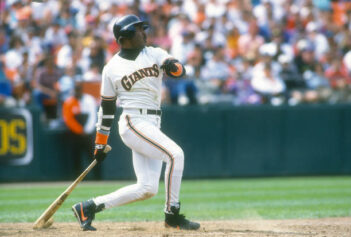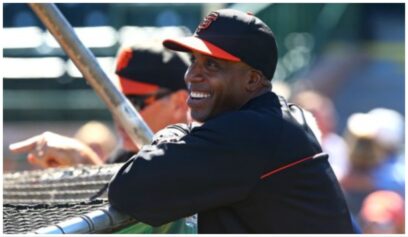This is part of The Shadow League’s yearly Black History Month In Focus series celebrating Black excellence in sports and culture.
Barry Bonds should be in the Hall of Fame. We know this. Bonds was considered a Hall of Famer with the Pittsburgh Pirates before his alleged “juicing” accusations and according to MLB Network had an 8.4 career WAR before he ever started “allegedly” juicing and blasting missiles into the waters of McCovey Cove, which sits past the right-field wall at AT&T Park.
Before he eventually zoomed past the great Hank Aaron for No. 1 on MLB’s coveted all-time home run list.
READ MORE: This Day In Black Sports History: Hank Aaron Becomes MLB’s Highest-Paid Player
This particular list encompasses the greatest African-American MLB players who have not been voted to the Hall of Fame and are not named Barry Bonds. It’s only right that a wide range of Black Knights and the accomplishments they made in the game of baseball be highlighted during Black History Month.
Curt Flood
Flood’s daughter Shelly told legendary baseball writer Bill Rhoden: “I want my father in the Hall of Fame because I understand that that institution houses the history; he is an important part of that history.”
On the 50th Anniversary of Flood vs. Kuhn, there was a petition for Flood to be inducted into Cooperstown. It should have happened in 2019 when Harold Baines, Lee Smith, and others got in. It didn’t happen in 2020 either.
As Rhoden said, “none of them has Flood’s revolutionary résumé, although each benefited from Flood’s act of defiance.”
Flood is best known for sacrificing his own career and sanity to introduce free agency to Major League Baseball, and the rest of American pro sports by proxy. His idolization of Dr. Martin Luther King Jr and Jackie Robinson, who just broke the color line in 1947 with the Brooklyn Dodgers, drew the then impressionable 24-year-old to Mississippi to participate in a non-violent protest.
It would change his life forever. His sacrifice, and subsequent abandonment by other MLB players, caused a deep depression that resulted in a divorce, a move to Spain, alcoholism and premature death in 1997 at 59 years old.
Flood, a historical icon to players who have salaries in the hundreds of millions now, was never appreciated by the MLB community while he was alive
Gary Sheffield
A rare power hitter, who also could also hit for average like the other studs on this list, Sheffield shook his mighty bat back and forth and blasted 509 homers in a 22-year career that spanned three decades and styles of play. He has more home runs than any African-American player of his generation with the exception of Ken Griffey Jr. (630) and the Big Hurt.
https://youtu.be/PV2lFQBedQY
Sheffield’s confrontational nature and his unfriendly discord with the media, as well as PED rumors (and a stint with the Yankees), has distorted his proper place among the greats of his era. He was a feared batsman, who started out as a shortstop (and the nephew of the great Dwight Gooden) then went to the outfield where he could flex his huge arm.
Despite nagging injuries, Sheffield managed to reach statistical standards that should make him a Hall of Famer. He’s got BBWAA HOF writer Rob Parker’s magic number of 500 homers. I mean, you’re going to tell me that Jeff Bagwell is that much better than Sheff, if at all?
Dick Allen
More than 40 years after the feared slugger has retired, Allen is still waiting to be inducted in Cooperstown. In an era characterized as the second dead ball era because homer production was low and pitchers were dominant on the mound, Allen batted .292, slugged .534, and had an OBP of .378 during his 15-year career. Statistically, he is a Top 20 hitter in MLB history.
Swinging a Paul Bunyan style 40 oz. bat, Allen became a seven-time All-Star, won the ’64 NL Rookie of the Year Award, the ’72 American League MVP Award and was considered one of the most feared hitters of his generation. He led the American League in homers twice, ending his career with 351 blasts and 1,119 RBIs. He was a model of consistency, hitting least 20 homers in 10 seasons, including six seasons with at least 30.
The first decade of his career alone is Hall of Fame worthy as he was arguably the best player in the game. He was also a black third baseman which is relatively non-existent in today’s pro game.
Sadly enough, Allen passed away in 2020, still waiting for his Cooperstown call.
Fred “Crime Dog” McGriff
McGriff hit 493 homers in his MLB career. Clean homers. But baseball’s HOF voting committee doesn’t deem the guy we called Crime Dog worthy of HOF induction. His career has been described as subtle and very good but not elite. He might end up with more homers than any PED-free player to never make Cooperstown.
McGriff was just never a transcending personality. He was tall and his bat was thundering, but few folks refer to the word great and Fred McGriff in the same sentence.
Some say McGriff was overshadowed by the prolific stars of his era.
He finished with the same number of dingers as Lou Gehrig, but the soft-spoken slugger broke in with Rafael Palmeiro, Mark McGwire, Jose Canseco, Ken Griffey Jr., Barry Bonds and other larger-than-life stars of the late ’80s and ’90s.
READ MORE: Barry Bonds Is On MLB Death Row Until He Confesses To PED Use
These more charismatic superstars soaked up all of the media ink and left few accolades or national commercial spots for a guy who played for mediocre franchises in Toronto and San Diego at the beginning of his career, before joining Atlanta and contributing to a World Series team.
He did have a nickname though and you have to earn those in baseball. They mean something.
There aren’t too many power-hitting brothers who play first base and smack bombs. Ryan Howard was the last one I can remember, but Fred McGriff was thorough like Chuck Scarborough before Howard and he hit .284 for his career which started in 1986 and ended in 2004. McGriff continued Eddie Murray’s lofty standard at that position for African-Americans.
Putting McGriff in is certainly not lowering the standards of the Hall of Fame.
Dave Parker
David Parker is nicknamed “The Cobra.” Parker was a feared slugger who was a magnificent outfielder and could also hit for average.
Big Dave was the 1978 National League MVP and a two-time batting champion. His dynamic skill set was not ignored as Parker broke financial ground for MLB players by becoming the first professional athlete to earn an average of one million dollars per year, having signed a 5-year, $5 million contract in January 1979.
Parker’s career achievements are lethal. However, a drug problem eroded his skills and contributed to injuries and bad knees that hindered his production and reputation.
Still, Parker managed to pump out 2,712 hits, 339 home runs, 1,493 runs batted in and a lifetime batting average of .290. Since retiring, the 69-year-old Parker has had both of his knees replaced and in 2013, he confirmed that he’d been diagnosed with Parkinson’s disease.
NL@AL: Parker throws out Downing at the plate
7/17/79: Dave Parker throws out Brian Downing at the plate with some help from Gary Carter Check out http://MLB.com/video for more! About MLB.com: Baseball Commissioner Allan H. (Bud) Selig announced on January 19, 2000, that the 30 Major League Club owners voted unanimously to centralize all of Baseball’s Internet operations into an independent technology company.
Parker was undoubtedly one of the most talented and dominant players to ever grace a diamond. His contributions to the game are not appreciated fully to this day.
These guys may not get that BBWAA love, but TSL gives them much props during Black History month as overlooked MLB gems who deserve their baseball immortality.



